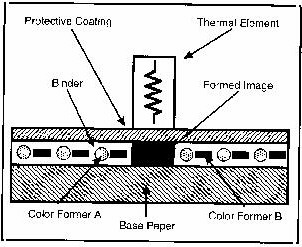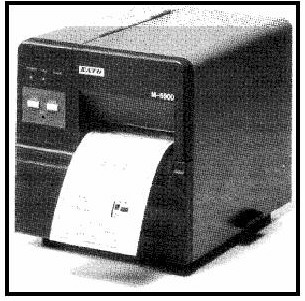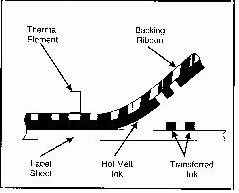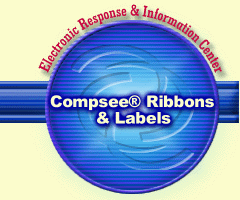Section 2: Selecting A Print Technology
All of the major print technologies have some advantages
and disadvantages when used in a demand label application. It is
possible to make a particular technology fit the application, but
this generally involves compromises that may not make sense. It
is more practical to select a printer based on a set of reasonable
tradeoffs. For instance, a label printer is not often used for printing
text documents, so this capability should not be included in the
primary selection criteria.
Before requirements can be matched to a particular
type of printer, something must be known about the different characteristics
of the technology and what they mean to bar code printing. Most
of the familiar print technologies were developed for producing
human readable text information. They can be modified to print bar
codes, but what makes a good text printer does not necessarily make
a good bar code printer. The more successful bar code printers have
been optimized for this purpose. An example of optimization for
bar code printing is the shape of the print dot used by matrix printers.
A square or rectangular dot makes a bar with a very defined edge,
something scanners like to see. A round dot produces a bar with
a scalloped edge, harder for the bar code scanner to read, but it
makes a human readable character that is more pleasing to the eye
than the harsh corners of the square dot. Square dots make better
bar codes while round dots are better suited for text documents.
Another differentiation is the size of the print field. Text printers
are designed to print document size pages, while label printers
limit themselves to practical label sizes.
Direct Thermal
Direct thermal printing has more of a public image
problem than a performance problem. While it is sensitive to heat
and ultraviolet light, the degree is much less than most people
suppose. It does offer one unique advantage not available in any
other of the technologies presented here. It does not depend upon
a secondary substance transfer to generate a mark on the paper.
Direct thermal printing chemically alters a coating to produce the
desired image. There is no secondary ink substance that must be
disassociated from a carrier and made to adhere to the label surface.
If the thermally active layer is covered by a protective coating,
as all thermal printer manufacturers recommend, the image is shielded
from surface abuse and contamination. The only thing that can get
to it without first having to break down the protective layer is
radiated energy in the form of either heat or ultraviolet light.
Foreign contaminates or surface abuse must first destroy the protective
coating before affecting the image.

Thermal Printing
� ADVANTAGES
- Quality -
Because of the square image elements and the non-reliance on a
secondary substance transfer, direct thermal labels produce high
quality bar codes with excellent bar edge definition. � Simplicity
- The absence of any ribbon/toner mechanisms makes the direct
thermal mechanism inherently simple. This results in a less
complex media loading path for more user friendly consumables
handling.
- Resolution -
The thermal print elements can produce a consistent dot pattern
down to 5.0 mils (200 dpi) when printing in a horizontal mode
(parallel to the paper movement). This allows ultra high density
bar code printing. When printing in a vertical mode however, the
speed must be reduced significantly to allow the elements to cool
down before stepping to the next print position. While it is
possible to print bars down to 5.0 mils when the print speed,
paper sensitivity and power applied to the elements are carefully
matched, it is best to avoid printing narrow dimensions of less
than 10 mils in the horizontal mode and 15 mils in the vertical
mode.
- Cost - The elimination of any ribbon/toner mechanism
results in a lower initial printer cost. It also results in a
more favorable consumable cost when compared to either thermal
transfer or laser printers.
� LIMITATIONS
- Environment -
The two most severe environmental limitations are exposure to high
temperatures or prolonged exposure to direct sunlight. The
development of new thermal papers has pushed the upper temperature
range upward to about 2120F and special ultraviolet filter
coatings can be applied that will extend the exposure time to
sunlight from weeks to months and will retain an acceptable
quality image for most purposes.
- Spectral Response - The bars created by the standard thermal dyes used
in the label coatings are relatively transparent to infrared
light, limiting the usefulness of standard label media to visible
light scanners. Special label coatings are available that work
with both visible and infrared light sources, but also increase
the cost of the label. If it is to be read by both types of
scanners, then the infrared stock should be specified.
- Media - The thermal paper used must match the characteristics
for which the printer was designed. Because of the various "speeds"
(sensitivity to heat) available in thermal papers, not all printer
and paper combinations are compatible. When properly matched however,
they will yield excellent quality bar code symbols.

SATO M-5900 Thermal Printer
Thermal Transfer
Thermal transfer printing is basically a direct thermal
process that has a ribbon interposed between the head and the label.
The heat from the print head is used to release the ink from a mylar
ribbon and make it adhere to the label surface. Since this type
of thermal process now relies upon a secondary substance transfer,
some of the advantages of direct thermal are lost, but heat restrictions
have been improved and sensitivity to ultraviolet light has been
eliminated.
� ADVANTAGES
- Quality - The
ink transferred to the label surface produces excellent bars with
quite high contrast ratios which are very stable and resist
deterioration. The use of square print dot elements also gives
excellent bar edge quality.
- Resolution -
The thermal print elements can produce a consistent dot pattern
down to 3.3 mils (300 dpi) when printing in a horizontal mode
(parallel to the paper movement), allowing ultra high density bar
code printing. When printing in a vertical mode however, the speed
must be reduced significantly to allow the elements to cool down
before stepping to the next print position. While it is possible
to print bars down to 5.0 mils when the print speed, paper, ribbon
and power applied to the elements are carefully matched, it is
best to avoid printing bar codes with a narrow dimension of less
than 10 mils in the horizontal mode and 15 mils in the vertical
mode.
- Speed -
Because it takes less energy to release the ink from the ribbon
than it does to develop a dot using thermally sensitive paper, the
print speed of thermal transfer printers is faster than their
direct thermal cousins. With the same print head and mechanism, it
is typically twice as fast when printing comparable images in the
direct thermal mode.
- Dual Mode Printing - Since the thermal transfer printer is essentially a
thermal mechanism with a ribbon positioned between the head and
the paper, it can also be used to print in a direct thermal mode
if the ribbon is not used. However, the head life will be
considerably reduced because it is no longer protected by the
ribbon.
- Media Selection - Bar code symbols can be generated using
a wider range of paper and vinyl substrates that are more resistive
to heat, water and light than in the direct thermal process. By
proper selection of the label material and the ribbon, a very
strong bond may be obtained between the ink and the label surface,
giving performance comparable to direct thermal labels with protective
surface laminations.
� LIMITATIONS
- Ribbons - The
ribbons are single pass and the printing of a single dot in a row
wastes the remaining ink on that row. This results in a very high
ribbon usage and associated cost. The ribbons are a thin mylar or
similar material coated with ink on one side and can be difficult
to handle, especially if they are very wide.
- Label Cost -
Because of the high ribbon usage, usually on the order of one
ribbon roll for each two rolls of labels, the cost of labels is
higher than with most of the other common technologies.
- Ribbon/Media Compatibility - The adherence of the ink
to the surface is the source of most of the durability problems
with thermal transfer images. If improper ribbon formulations
are used, the transferred ink may flake at the edges when contact
scanners are used, or become smudged from oily finger prints.

Thermal Transfer Printing
Press Printing
This category encompasses all of the press technology
available for off-site printing. This includes film masters, flexography,
offset lithography, gravure, letterset, hot stamping and many others.
It offers the widest range of quality labels available for bar code
printing. The most important step for procuring off-site printed
labels is the generation of a good specification for the label,
detailing the precise dimensions of the symbols and media upon which
they are to be printed. Selection of a label vendor should be based
primarily upon their experience and reputation. This probably won't
be the lowest cost bidder, but will most likely represent the lowest
overall cost if headaches and mistakes are taken into consideration.
� ADVANTAGES
- Label Material Selection - Because of the many print processes available for
use, the range of materials available on which bar codes may be
printed is almost limitless. Special materials are available for
high temperatures, and even metal plates can be imprinted with bar
coded information.
- Cost - If a
large quantity of identical labels are required and they do not
have any special requirements to drive up the price, cost per
label will be relatively inexpensive.
- Quality -
High quality should be expected for press printed labels. While it
is possible to get low quality labels using off-site vendors, the
cause can usually be traced to poor workmanship or a lack of
understanding of the bar code symbol requirements. Excellent
quality labels that survive under harsh conditions can be obtained
by the selection of the correct print process and base label
material.
- Label Size - The printable label size is limited only
by the dimensions of the press web, which can be very large.
� LIMITATIONS
- Variable Data
- It is difficult to print labels where each one must contain
different data. Even sequential numbering using bar code symbols
is a task. It involves not just the changing of a single
character, but the rearrangement of a series of bars and spaces.
- Advance Data
- The data for the label(s) to be printed must be known far enough
in advance to allow for the preparation of the print masters and
scheduling of press time. If special labels are needed, extra time
must be allowed to obtain any non-standard materials.
- Cost - If only a small number of labels are needed, the cost
per label can be high, reflecting set-up charges that are now
prorated over fewer labels.
Solid Font Impact
Solid font impact printers come the closest to typewriters
in technology and limitations. They print the bar codes by constructing
the symbols with preformed bars or by printing the complete character
with a single hammer blow. The constructed code method must be used
if the symbol to be printed represents a large area per hammer blow,
or if a continuous code is chosen.
� ADVANTAGES
- Simple Interfacing - Send the printer a character code and that is
what it prints. No worrying about aspect ratios, different code
symbologies, etc.
- Quality - Since each bar is precisely formed, the edge
definition is excellent and good quality bar code symbols are
produced.
� LIMITATIONS
- Fixed Format
- Since each bar or symbol is preformed, the label format,
symbology codes or character densities cannot be changed without
changing the code wheel. Alpha characters may be printed, but are
restricted to a particular location determined by their position
on the code wheel. All symbols must be printed in the same
orientation, and orthogonally (i.e. at right angles) printed
symbols cannot be produced.
- Speed - Each
bar or symbol is located sequentially on the code wheel and the
print speed is limited by the rotational speed of the wheel.
- Mechanical -
The operation of the mechanism depends upon numerous moving parts
with large masses. The hammer blows and code wheel rotation must
be properly synchronized or smearing will result.
- Symbol Area - If small area symbols are printed, there
is a tendency for "ticking" to occur. This is ink transfer in
areas between characters or on edge of adjacent characters.
Impact Dot Matrix
Dot matrix printers are very popular in the computer
industry for document printing. Many have been pressed into bar
code service because they are cheap and everyone with a computer
probably already has one. However, the ones best suited for bar
code applications are the line printer types, the ones that are
not cheap and only used in limited computer applications. The most
effective dot matrix printers generally have additional intelligence
in the form of a graphics controller card to reduce transmission
time for complex labels.
� ADVANTAGES
- Versatility -
Dot matrix printers are one of the most versatile types available.
They can print bar code symbols or text documents in any
orientation and with various height and width symbols. They are
especially adept at printing multi-copy forms that include bar
code symbols for document tracking and control. When printing bar
codes on multi-copy forms however, the top copy will be the only
one readable by a scanner.
- Equipment Cost - Dot matrix printers are used in large
quantities by the computer industry and the initial cost of the
equipment is low. However, care should be exercised in selecting
a dot matrix printer for bar code applications on the basis of
price or availability. Also make sure it can print suitable quality
symbols.
� LIMITATIONS
- Carriage Width - Most of the common dot matrix printers were designed
primarily for printing documents. The width of the carriage is
determined by the smallest sheet size (usually 8.5 x 11'). Bar
code labels tend to be much smaller and have to be printed
"multiple up" to take advantage of the print speed. Also, if the
printer uses the standard puller tractor arrangement, the label
must clear the tractor assembly before it is easily accessible.
Fitting a label stripper or cutter to such a printer presents some
mechanical challenges.
- Quality -
When used to print bar code symbols, dot matrix printers have
several factors going against them. First, the edge definition of
the bar is poor and overlapping dots must be used to meet the
specifications. When overprinting to increase the bar density and
fill in the ragged edges, new ribbons will bleed excessively at
the bar edge causing bars to be too wide and the adjacent spaces
too narrow, while worn ribbons not containing enough ink will tend
to print the bars will too narrow with adjacent spaces being too
wide. Second, irregular paper spacing will cause problems with
vertically printed symbols. If the printer uses a serially driven
head, then irregular head motion will result in problems with
horizontally printed symbols.
- Spectral Response - The standard ink in a dot matrix printer ribbon is
not readable to scanners using infrared light. Carbon must be
added to make it infrared scannable, but carbon will cause the
print head to wear out prematurely. Special mylar ribbons using
carbon have been developed to overcome this problem, but most are
single pass and have a very limited lifetime. The dry carbon
transferred from the mylar ribbons must adhere to the surface
since it is not absorbed by the label material.
- Resolution - The best resolution offered by dot matrix
printers comes from the 24 pin print heads that use 8 mil diameter
print wires. When ink bleed is taken into consideration, the dot
size will end up between 9 and 10 mils, giving a medium density
bar code symbol at best. When printing low density symbols such
as those called for by the AIAG B-3 Shipping Label, the 8 mil
wire requires several overlapping dot rows to print the proper
bar width. Conversely, printers using nine pin heads with 12 mil
print wires can create the symbol more easily, but are limited
to printing only low density bar codes.
Laser
The term laser is used here to refer to any printer
using a xerographic or similar type of printing process. Liquid
Crystal Shutter (LCS) arrays, Light Emitting Diode (LED) arrays
or lasers are used to expose the surface of the image drum, with
the laser being the most popular. These printers are invariably
page printers and are not well suited for demand label applications.
They are most commonly sheet fed printers, but some of the newer
laser printers designed for bar code applications employ a tractor
feed system whereby continuous forms may be used.
� ADVANTAGES
- Aesthetics -
Laser printers commonly have a resolution of at least 300 dots per
inch, with some of the newer models being capable of printing at
600 or 1200 dpi. This allows them to print almost typeset quality
characters and high resolution graphic images. These can be
combined with bar code symbols on a label to produce very nice
looking labels with complicated designs.
- Resolution -
At 300 dots per inch resolution (a 3.3 mil dot size), laser
printers can create ultra high density bar code symbols. However,
it is not generally recommended that bars be printed less than 6.6
mils (two dots wide on a 300 dpi printer) unless the symbol is to
be scanned in closed loop applications where the scanning
equipment used can be controlled.
- Multi-Application - Lasers are the printers of choice
for documents where bar code symbols and quality document printing
must be intermixed.
� LIMITATIONS
- Page Printer
- Since laser printers are basically page printers, it takes as
much time and media to print a single small label as it does a
large label. If it prints at six pages per minute, it takes 10
seconds to print a whole page or a single bar code symbol. Some of
the newer laser printers designed for bar code applications have a
variable page length feature, but the physical distance between
the imaging drum and the fusing roller prevents an image from
being placed immediately following the previous image. They are
therefore poor choices for typical demand label applications.
- Heat - Laser
printers use heat to fuse the toner to the surface of the paper, a
lot of heat. The adhesive coating on the back of a label tends to
seep out between the die cut edges when heat is applied. In ion
deposition printers, the heat is replaced by pressure, but the
result can be the same. Special adhesives must be specified for
these printers.
- Label Imaging Time - Because of the large number of dots
per inch, the time required to image a label can be substantial.
Compounding the problem is the requirement for a complete page
to be imaged even if it consists of a number of identical smaller
labels.
Ink Jet
Ink jet printing has several drawbacks when used
for printing bar code symbols, but does find some use in specialized
applications. The main problems with bar code printing are involved
with the formation and control of the dot. Since the ink is absorbed,
the paper porosity, ink viscosity and drying time must be carefully
controlled. The most pronounced symbol quality problems are associated
with the edge definition, contrast ratio and consistent bar widths.
Some of the new ink jet techniques use a solid ink that is liquefied
with heat and placed on the paper where it reverts to its solid
state. This gives better edge definition and contrast ratios but
leaves a raised print image which can cause problems with contact
scanners. Special ink jet systems have been developed to print low
resolution bar codes directly on corrugated surfaces. Using independently
mounted nozzles, the images are formed as the container is moved
by on a conveyor system.
� ADVANTAGES
- Non-contact - The primary advantages of ink-jet printing
is that it is a non-contact printing technology. This removes
any wear on the head due to contact abrasion. This also allows
surfaces with irregular finishes to be printed if they are compatible
with the ink.
� LIMITATIONS
- Media Surface
- The ink must be absorbed into the surface of the media,
requiring a controlled surface porosity and finish. Because bar
codes involve much higher printing densities than text, the media
requires a longer period of time to dry sufficiently before it can
be handled without smearing.
- Ink Formulation - The ink must dry quickly, but not in the nozzle.
The compromise between these two extremes requires the head to be
purged or cleaned between print jobs. Water based inks are also
very susceptible to exposure to moisture. A single drop of water
can render a bar code unreadable.
- Infrared Response - If infrared scanners are used, carbon
or some other infrared absorbing material must be added to the
ink. This can cause excessive wear on the ink nozzles.
Matching Technology and Requirements
The selection of the proper technology for generating
bar coded labels is a very complex process. It involves not only
an understanding of the print technology to be used, but the label
usage requirements as well. These two bodies of knowledge must be
combined in the selection process to ensure that the bar code labels
produced will give satisfactory performance for their required lifetime.
Some of the factors to be considered are:
- What are the environmental requirements?
- What is the total cost target per label?
- Does the data content change?
- How will the label be scanned?
- How will the label be applied?
- How often will a label be required i.e., (10 labels per second,
etc)?
Copyright � 1998
Sato America, Inc.
Return
to Media Index
|



